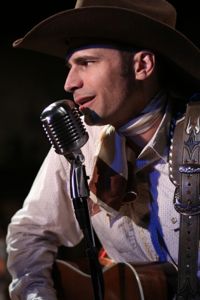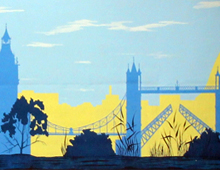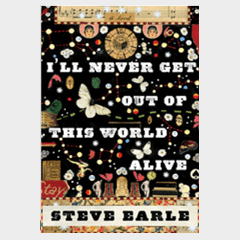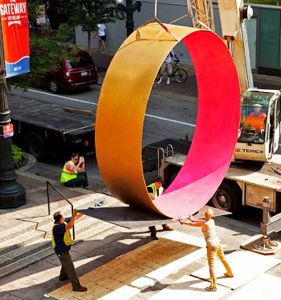How I spent my week…theater, art, music
Posted: September 25, 2013 Filed under: Art & architecture, Music, Rock and roll, Theater | Tags: Athenaeum Theatre, Interrobang Theatre, Museum of Contemporary Art, Steve Earle, the Bauhaus, The Vic, Ukrainian Institute of Modern Art 1 CommentA great theater experience, plus some cartoon art and memories of the Bauhaus. The finishing touch was a Steve Earle concert. Am I lucky to live in Chicago or what?
Terminus at Interrobang Theatre Project
Mark O’Rowe is one of the new generation of Irish playwrights whose work was first seen in the 1990s. In Terminus, being presented by Interrobang Theatre Project, he displays his fascination with language and his passion for words. Terminus isn’t so much a play as a series of stories, intertwined in monologues by three characters, known only as A, B and C. Their stories, set in the streets of Dublin, begin separately and gradually become more connected, until they are finally merged in a glorious fantasy of blood, sweat, tears and sex. That’s how my review of Terminus begins. It’s a terrific play with thrilling language. Truly a treat to listen to. I recommend it highly.
Modern Cartoonist: Daniel Clowes exhibit at MCA
Daniel Clowes is a well-known graphic novelist, who has published nearly 50 books and magazines. Modern Cartoonist: The Art of Daniel Clowes is his current exhibit at the Museum of Contemporary Art, which runs until October 13. The show is beautifully designed and curated and has many lovely little graphic surprises.
It was very interesting to see the progression and process of Clowes’ work, sometimes from sketch through inking and printing. For some publications, a series of pen and ink on tissue pages was shown. Since so much art today is created on the computer, it’s fascinating to see so many of Clowes’ pages drawn by hand on paper.
Image: Collection of Daniel Clowes. Courtesy of the artist and Oakland Museum of California
Chicago’s Bauhaus Legacy at the Ukrainian Institute of Modern Art
 It’s been years since I visited this little gem of a museum on Chicago Avenue in Ukrainian Village. Do not think it’s only about Ukrainian art; it’s really a center for modern and contemporary art. The Bauhaus exhibit is fabulous and it’s open through this Sunday, September 29. If you are interested in modernism, you don’t want to miss it.
It’s been years since I visited this little gem of a museum on Chicago Avenue in Ukrainian Village. Do not think it’s only about Ukrainian art; it’s really a center for modern and contemporary art. The Bauhaus exhibit is fabulous and it’s open through this Sunday, September 29. If you are interested in modernism, you don’t want to miss it.
The legacy starts with Lazslo Moholy-Nagy moving to Chicago to establish the US version of the famous German citadel of design. The Bauhaus’ existence was threatened in the 1930s by Hitler’s aversion to modern art. Moholy-Nagy was followed by other artists and designers who moved to Chicago (including Mies van der Rohe). The New Bauhaus went through many name changes and locations and in 1949 became part of the IIT Institute of Design.
The exhibit includes about 150 pieces by 90 artists and designers. Work includes painting, sculpture, photography, architecture plans, furniture and design pieces. A lovely example of the latter is a bar of Dove soap, designed by three students in 1952 as part of a special project funded by Lever Brothers. Dove still uses the same shape for its soap bars. (The original carved wooden prototype is on show at the Chicago History Museum.)
In addition to the main exhibit in the west gallery, the east gallery includes Bauhaus work from the institute’s permanent collection. There’s also a very interesting wall that shows the birth and development of the Ukrainian institute.
I’m going to write a feature on the institute for Gapers Block and I’ll provide a link to it here when I do.
Steve Earle and the Dukes played a great concert at the Vic Saturday. The setlist included many of his fine old songs as well as tracks from his new album, The Low Highway. His band is made up of four musicians: a drummer, upright bass player, lead guitarist and fiddler/mandolin player. Earle plays a number of stringed instruments himself (guitar, mandolin, banjo) and sings lead vocals. Many of his songs (and his occasional patter between songs) involve social commentary. Here are a few lines from the song “The Low Highway.”
Heard an old man grumble and a young girl cry
A brick wall crumble and the white dove fly
A cry for justice and a cry for peace
The voice of reason and the roar of the beast
And every mile was a prayer I prayed
As I rolled down the low highway.
His novel–I’ll Never Get Out of This World Alive–is on my reading list and coming up soon.
Theater update: Three you can see
Posted: September 16, 2013 Filed under: Movies, Music, Theater | Tags: American Blues Theater, Hank Williams, Shattered Globe Theatre, Sideshow Theatre, Theater Wit 3 CommentsIt’s theater season again and I have three new reviews that you’ll be interested in. Plus a special tip on what to see in the future.
Theater picks
9 Circles at Sideshow Theatre
9 Circles takes us through the depths of Dante’s Inferno by telling the story of an Iraq war veteran who is accused of a terrible crime. The play presents a series of two-person scenes between the ex-soldier and a series of helpful or surreal professionals. The story moves from accusation to trial to execution. The play is gripping, intense and discussion-provoking. It’s a terrific performance by Andrew Goetten, who plays the ex-soldier, and by the other actors in multiple roles. You can read my Gapers Block review here.
The photo at left is the one I reference in the first paragraph of the review. The photo is from the @historyinpix Twitter page and titled “Soldier in Vietnam, 1965.” Click to enlarge it and read what the soldier has written on his helmet.
Hank Williams: Lost Highway at American Blues Theater
This is a lively musical biography but of course the underlying story is tragic. Hank Williams was a brilliant country-blues singer/songwriter in the  1940s and early 1950s. He influenced many performers who followed him and the play suggests how he was a link to the African-American blues musicians of the period. His life was cut short at the age of 29 because of his addictions to alcohol and prescription drugs. The ABT play does a good job of telling both the tragic story and making you happy to hear a healthy setlist of Williams’ songs. The band (Williams’ Drifting Cowboys) is made up of some excellent Chicago musicians and Matthew Brumlow as Hank comes close to channeling his image, his voice and musical style. Read my Gapers Block review here.
1940s and early 1950s. He influenced many performers who followed him and the play suggests how he was a link to the African-American blues musicians of the period. His life was cut short at the age of 29 because of his addictions to alcohol and prescription drugs. The ABT play does a good job of telling both the tragic story and making you happy to hear a healthy setlist of Williams’ songs. The band (Williams’ Drifting Cowboys) is made up of some excellent Chicago musicians and Matthew Brumlow as Hank comes close to channeling his image, his voice and musical style. Read my Gapers Block review here.
Photo by Johnny Knight; courtesy of American Blues Theater.
Other People’s Money at Shattered Globe Theatre
This is a witty and fast-moving play about corporate raiders in the late 1980s. You remember them, don’t you? Michael Milken, Victor Posner, Carl Icahn? The financial crisis of five years ago this month has brought other corporate names to the forefront. Jamie Dimon, Richard Fuld and Hank Paulson; companies like Lehmann Brothers, Bear Stearns and AIG. So the raiders and their takeovers seem a bit dated now. Nevertheless, this is an interesting and entertaining play and I recommend it. Ben Werling is terrific as Larry the Liquidator. Think of it, as I said in my Gapers Block review, as a drawing room comedy of the 1980s.
NT Live in HD
The Audience, a National Theater Live encore presentation
 The National Theatre of London broadcasts live performances of some of its productions to theaters around the world, similar to the Metropolitan Opera Live in HD broadcasts. NT Live broadcasts a live performance and several encores at the two Northwestern University theaters in Evanston, at the Music Box in Chicago and Renaissance Place in Highland Park.
The National Theatre of London broadcasts live performances of some of its productions to theaters around the world, similar to the Metropolitan Opera Live in HD broadcasts. NT Live broadcasts a live performance and several encores at the two Northwestern University theaters in Evanston, at the Music Box in Chicago and Renaissance Place in Highland Park.
Last week we saw the final broadcast of the commercial, West End production of The Audience by Peter Morgan. Helen Mirren stars as Elizabeth II of England and some talented actors as her various prime ministers over the years. The play is a series of scenes, in random, not chronological, order, in which Mirren ages or reverses her age with very quick changes of wig and costume. It’s brilliantly acted and riveting as it takes the viewers through historical events of Elizabeth’s long career. Her first audience was with Winston Churchill in 1952 and the latest with David Cameron in 2012.
Future NT Live productions this season are three Shakespearean tragedies: Othello, Hamlet and Coriolanus.
Mirren as Queen Elizabeth; photo copyright National Theatre Live.
Remembering Chile’s 9/11
Posted: September 13, 2013 Filed under: Movies, Music, Politics, Theater | Tags: Ariel Dorfman, Bruce Springsteen, Victor Jara, Victory Gardens Theatre 8 CommentsRemembering 9/11/73, the day that changed everything–in Chile
We observed the 12th anniversary of the 9/11 attacks on the World Trade Center this week. News channels had at least one story on the memorial observances. MSNBC relived the entire experience, replaying the NBC news footage from that fateful morning, minute by minute.
 In Santiago, Chile, they remembered their own 9/11, which had an even more profound impact on Chilean society. The Christian Science Monitor reported that “President Sebastian Pinera marked the 40th anniversary of the military coup that overthrew Salvador Allende on Wednesday by urging Chileans to heal from—but never forget—the events of Sept. 11, 1973, that launched a bloody 17-year dictatorship.” Allende was a democratically elected socialist who launched the “Chilean path to socialism.” He nationalized the copper industry (mostly owned by US companies) and used the money to improve education and health care for his people. The US–meaning the CIA–found a way to sow chaos and provoke the military coup. Chile’s national history museum opened an exhibit this week to mark the anniversary.
In Santiago, Chile, they remembered their own 9/11, which had an even more profound impact on Chilean society. The Christian Science Monitor reported that “President Sebastian Pinera marked the 40th anniversary of the military coup that overthrew Salvador Allende on Wednesday by urging Chileans to heal from—but never forget—the events of Sept. 11, 1973, that launched a bloody 17-year dictatorship.” Allende was a democratically elected socialist who launched the “Chilean path to socialism.” He nationalized the copper industry (mostly owned by US companies) and used the money to improve education and health care for his people. The US–meaning the CIA–found a way to sow chaos and provoke the military coup. Chile’s national history museum opened an exhibit this week to mark the anniversary.
Chilean writer Ariel Dorfman had a poignant article in the September 8 New York Times, titled “9/11: The Day Everything Changed, in Chile.” He and his friend Claudio Jimeno were among four advisers to President Allende when the government was under threat of a military takeover by the forces of General Augusto Pinochet. The advisers rotated nights at La Moneda, the presidential palace, to keep watch and alert the leader to any emergency. Dorfman was to keep watch on Monday night, September 10, but changed nights with his friend because of a family obligation. The rest is history, of course. Jimeno was taken prisoner in the coup, tortured and became one of the desaparecidos.
Dorfman is author of the novel and play Death of the Maiden, which has been dramatized on screen as well as stage. Victory Gardens Theatre will mount a production of the play in June 2014. The 1994 film starred Sigourney Weaver as the activist who believed she had been raped and tortured by a doctor who befriends her husband. The events could have happened in most any country under siege today, but it was Chile. Chile after 9/11.
Bruce Springsteen honors Victor Jara, Chilean hero
Bruce and the E Street Band performed in Santiago, Chile, on September 11, their first show in South America since the Amnesty International Human Rights Now! tour in 1988. Bruce took the opportunity to honor Victor Jara, Chilean poet, activist and Allende supporter, by performing his song “Manifiesto” during the encore set. Jara was tortured and killed after the 1973 coup.
Film odysseys, digital and analog
Posted: September 8, 2013 Filed under: Digital life, Movies, Music | Tags: Dave Grohl, Sound City 1 CommentHere are my strong recommendations on three films that illustrate the history of film and music and how technology has affected both art forms. All three films are fascinating and deserve our attention if we care about the popular culture that affects our lives.
The Story of Film: An Odyssey
 A new series on the history of film (no yawns, please) just started running on cable channel TCM. It’s based on a 15-part, 900-minute documentary series titled The Story of Film: An Odyssey, created by Mark Cousins, a film critic from Northern Island and author of a 2004 book of the same title. The first chapter ran last Monday night (September 2) on TCM and will continue for the next 14 Mondays, at 9pm CT. TCM creates a whole evening around the theme of that week’s episode, showing some of the films referenced before and after The Story of Film episode. You can see the list of films referenced in each episode here. The image in the film poster above is from the 1902 George Méliès film, A Trip to the Moon. (You may remember Méliès as the owner of the toy shop in the recent film Hugo.)
A new series on the history of film (no yawns, please) just started running on cable channel TCM. It’s based on a 15-part, 900-minute documentary series titled The Story of Film: An Odyssey, created by Mark Cousins, a film critic from Northern Island and author of a 2004 book of the same title. The first chapter ran last Monday night (September 2) on TCM and will continue for the next 14 Mondays, at 9pm CT. TCM creates a whole evening around the theme of that week’s episode, showing some of the films referenced before and after The Story of Film episode. You can see the list of films referenced in each episode here. The image in the film poster above is from the 1902 George Méliès film, A Trip to the Moon. (You may remember Méliès as the owner of the toy shop in the recent film Hugo.)
The first episode covering 1895 to 1918 starts with early moving pictures made by Thomas Edison in New Jersey and the Lumière brothers in Lyon, France. Cousins pays attention to changes in film editing and the evolution of movie theaters from nickelodeons to grand movie palaces of Egyptian, art deco and other exotic decor.
As AO Scott wrote when the series was released last year: “It is global in scope, attentive to the political implications of film, generally director-centric and closely attuned to matters of form. There are interviews with academics and filmmakers, visits to cinematic landmarks and a wealth of wonderful clips.”
Watch the trailer.
Side by Side
 Are you a movie junkie like me who loves the technical side as well as the creative? Then you will appreciate the 2012 documentary, Side by Side, which looks at changes in film technology and focuses on the switch from photochemical film to digital projection. That technology revolution is highly controversial in the movie business, although most theaters have switched to digital completely. (The Gene Siskel Film Center still shows both formats and usually indicates format in its listings.)
Are you a movie junkie like me who loves the technical side as well as the creative? Then you will appreciate the 2012 documentary, Side by Side, which looks at changes in film technology and focuses on the switch from photochemical film to digital projection. That technology revolution is highly controversial in the movie business, although most theaters have switched to digital completely. (The Gene Siskel Film Center still shows both formats and usually indicates format in its listings.)
Side by Side shows the history and workflow of both kinds of filmmaking and illustrates what is gained and lost in both processes. Keanu Reeves is host and interviews directors and cinematographers about how the technology affects their filmmaking.
The film points out that digital production democratizes the filmmaking process because a filmmaker can go out alone with a single piece of equipment. A digital camera does not require the elaborate equipment and crew that celluloid film does. And it makes every film ever made available for instant viewing. That’s how I can watch old foreign and indie films now on DVD or streaming.
But many directors are saddened or angry by the change and insist the color and image richness of celluloid is lost in digital technology.
Sound City: Live sound, slain by technology
 The 2013 documentary Sound City tells much the same story about the music business. The 108-minute film, directed by musician Dave Grohl (Nirvana, Foo Fighters), tells the story of the legendary Los Angeles recording studio where bands like Tom Petty and the Heartbreakers, Nirvana, Neil Young, Johnny Cash, John Fogerty, Nine Inch Nails, Rage Against the Machine, Fleetwood Mac and Rick Springfield made great music.
The 2013 documentary Sound City tells much the same story about the music business. The 108-minute film, directed by musician Dave Grohl (Nirvana, Foo Fighters), tells the story of the legendary Los Angeles recording studio where bands like Tom Petty and the Heartbreakers, Nirvana, Neil Young, Johnny Cash, John Fogerty, Nine Inch Nails, Rage Against the Machine, Fleetwood Mac and Rick Springfield made great music.
Sound City never really joined the digital revolution and continued its tape-based recording in a venue where every room had its own sound quality. But once the digital revolution began, its demise was in sight. Many musicians still prefer the richer sound of tape-based, analog recording. But Sound City and the other great recording studios have disappeared. Grohl bought the original Neve soundboard from Sound City and has it installed in his own Studio 606.
This is a fine documentary, telling the story of a landmark musical institution, its impact on rock and roll, and its demise, slain by technology. Drummer/guitarist Grohl proves himself to be a filmmaker too.
The film will be shown again a few times this week on Palladia or VH1 Classic. And you can buy it from iTunes or on DVD.
Weekend update / no apologies to SNL
Posted: September 6, 2013 Filed under: Art & architecture, Digital life | Tags: E-readers, Old Irving Park, Tony Sparrow 1 CommentSuggestions for two new art installations to explore and some thoughts on reading.
New art and music on the State Street median
I wrote about the new State Street plaza in June when the public space on the State Street median opened. This pleasant parklet is still there, between Wacker Drive and Lake Street.
Tables and plantings create a place where you can read a book with your lunch or meet a friend for coffee.
Now there’s a new piece of sculpture at the south end of the plaza, created by Dusty Folwarczny. I updated the story about the plaza in Gapers Block this week.
And the Chicago Street Musicians play popup concerts at lunchtime occasionally. It’s an admirable urban oasis.
City melting pot: The new mural in Old Irving Park
 If you’re out and about Saturday morning, you can stop by Irving Park Road and Keeler Avenue for the dedication of the new mural celebrating the Old Irving Park community. You can read my story about it in Gapers Block. Artist Tony Sparrow led a team of artists to create the mural on both walls and all the pillars in the Metra/Union Pacific underpass just west of the Kennedy Expressway underpass. Tony was a delightful host when I visited last week to interview him and tour the neighborhood. (The image shown is a small portion of the mural; thanks to Tony for the image.)
If you’re out and about Saturday morning, you can stop by Irving Park Road and Keeler Avenue for the dedication of the new mural celebrating the Old Irving Park community. You can read my story about it in Gapers Block. Artist Tony Sparrow led a team of artists to create the mural on both walls and all the pillars in the Metra/Union Pacific underpass just west of the Kennedy Expressway underpass. Tony was a delightful host when I visited last week to interview him and tour the neighborhood. (The image shown is a small portion of the mural; thanks to Tony for the image.)
The mural is a world skyline titled Positive Babel: The World Lives, Works and Plays in Old Irving and celebrates the residents of some 70 ethnicities who live in the neighborhood. Old Irving is generally bound by Pulaski Road and Cicero Avenue east and west and Addison Street and Montrose Avenue north and south. The Old Irving Park Association has been working for the last 10 years to improve the neighborhood environment and one of its projects has been turning underpasses into art galleries. The Positive Babel murals are the 10th and 11th created.
If you want to explore the murals on foot, there’s easy street parking on Avondale just east of the Positive Babel underpass.
Reading on the CTA Redux
 Some time ago, I wrote about how I like to spy on what people are reading on the CTA. I said I never go anywhere without something to read because you never know whether the bus will get stuck in traffic or whether your lunch date will be running late. I complained about how anonymous e-readers keep me from spying on book covers (and I admitted that I read all formats—print, phone, Kindle and iPad).
Some time ago, I wrote about how I like to spy on what people are reading on the CTA. I said I never go anywhere without something to read because you never know whether the bus will get stuck in traffic or whether your lunch date will be running late. I complained about how anonymous e-readers keep me from spying on book covers (and I admitted that I read all formats—print, phone, Kindle and iPad).
Now here’s Transit Readings, a fun site where the blogger thrives on photographing people as they ride and read their books, real books. Sometimes the bus or rail line info is included too.
And here he explains what’s he’s doing and his rules for doing it. If you’re reading a book on the Blue Line or the #36, you may find yourself here.




